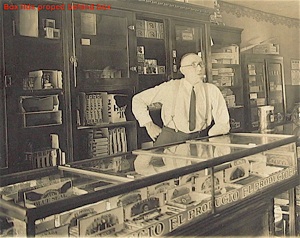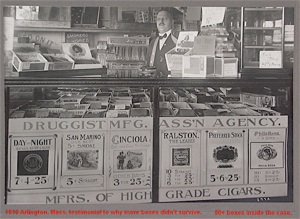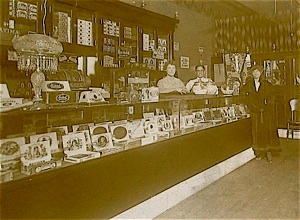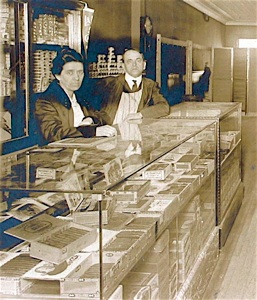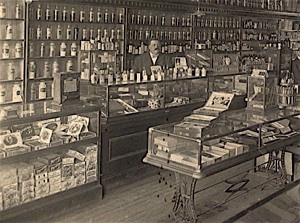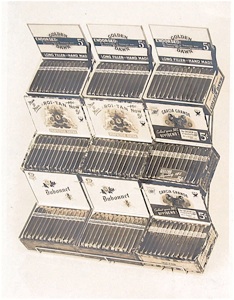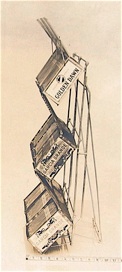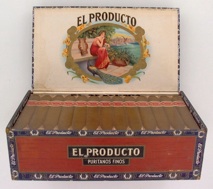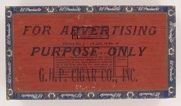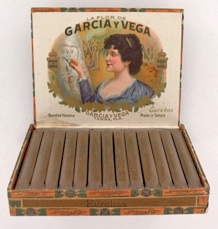How Boxes were Displayed
Let me count the ways
A National Cigar History Museum Exhibit
© Tony Hyman
Minor revisions: July 7, 2011

How Boxes were Displayed
Let me count the ways
A National Cigar History Museum Exhibit
© Tony Hyman
Minor revisions: July 7, 2011
The Federal Government cared about collecting taxes. It didn’t care how cigars were displayed. In large measure, neither did manufacturers, wholesalers, brokers or anyone else. Anyone else, that is, except salesmen. The guys in the trenches always wanted their brands up front, clearly visible. Just as in today’s retail world, salesmen and companies bribed, rebated, cajoled, and offered inducements. Banners, signs, window and back-bar paintings, clocks, cutters, lighters, mats, and decals were everywhere. Some salesmen offered big prizes, like Indians, shotguns, watches and wood stoves. But in the end, it was the merchant and his customers who decided.
Here are a few examples of displays I’ve found interesting. And horrible.
Dummy cigar boxes
Clockwise from UL: [8695] [8696] [4480] [5493] [6141] [8418]
Not all displays were in or on a cigar counter
These pictures are from a 1934 ad for a free standing floor display.
[3671] [3670]
Cigars were sold everywhere including this combination newsstand, cigar store and laundry. What has all these well-dressed young men’s attention? If it weren’t 1905 you’d think they were watching the world series on TV.
More interesting to a historian
or box collector is the assort-ment of shoe box type boxes of stogies seen lower left. Note too the two boxes of 250, in one of which the cigars lay flat
and in the other they stand on end.
[1784]
This apothecary’s cigar counter is a jumble.
Note the boxes stacked underneath the case, the result of customer demand and various quantity deals offered by salesmen. Note too the folding multi-tier box on the case in the center of the store accomplishing what it was designed to do, get up-front display. Boxes that unfold in various ways are called ‘mechanicals’ by the trade.
[3736]
Slanted lidless boxes emphasize the need for the brand name to be printed underneath the inner label. Frings Bros. cigars are displayed prominently on top the counter. Note the large Bull Durham bull behind the proprietor.
[3651]
Elevating the second row on the lower shelf wasted a lot of space, lessened the number of boxes that could be opened
(no room for a 3rd row to be seen), but made a very effective display.
[1750]
These candy store owners displayed boxes flat, lids flat, forming a shelf for a layer of boxes on top. More than two dozen brands cluttered the inside of their counter while the top remained clear, allowing the mess to be seen.
[1724]
Fortunately for box collectors, most retailers relied on the tried and true method of display: box open, lid on, ready to be emptied and given away. c.1910
[1728]
Lids were torn off the first two rows, but left on the back row. Slanted boxes make the cigars the star, not the label. Back flaps and bands are particularly important.
Another common way of displaying cigars, but not so good for box collectors.
[8218]
This retailer’s boxes are displayed flat, with lids torn off, but with no half lids sticking up. Back, front, and side tags become important when this type display is used. This was a common way of displaying cigars and a major reason why the brand name is printed at the bottom of inner labels and displayed on the back inside of a box. Lid removal is why some cigar companies print their brand on the liner as well.
[1733]
We’ll never know the thinking behind turning boxes in one case sideways and in the other facing front. And probably never care.
The value of a flat top glass counter is clear.
Two items atop that glass are rare, the White Beauty tin 25/up and the large box of 500 stogies along side the cash register. The size and shape of the two items forces retailers to put them on top where they’ll get seen by customers.
[1731]
These grocery operators chose sideways, but put lids straight up, back to back. Not too many shops chose this approach to display from what I’ve seen in period photos. It seems a little awkward for the customer but does show off the cigars better than other presentations.
[1716]
Sideways displays could be very effective greetings, showing the selection to the potential customer as he walks in the store.
From the Civil War to WWII, candy and cigars were a common retail combination. Self indulgence shops for all sexes.
[1756]
This saloon owner displayed boxes with lids open, but sitting sideways with the end of the box toward the front of the case. The display is three rows deep with a mirror offering an illusion of greater depth.
[1765]
Humidified countertop showcases
Showcases that could sit on top of existing counters appeared in the early 1870’s and became popular, coinciding with the time when labels began to appear inside U.S. cigar boxes.
This style case worked, and could still be found in neighborhood shops in the 1950’s. It’s biggest disadvantage was it left no flat top counter...on which to offer impulse items.
Demand for various brands outstripped this retailers space. No neatness awards here.
[1729]
Display in the U.S.
Early saloons, general stores and other small retailers often displayed boxes so that the end label showed in the days before humidified showcases.
Until the 20th century, most saloons were located in the front room of private homes.
[3740]
Europe before 1860
Before 1860 European tobacconists typically displayed stock on end. Showcases as we know them didn’t exist. Box sales made up a large portion of business.
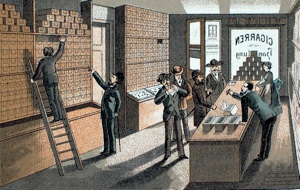

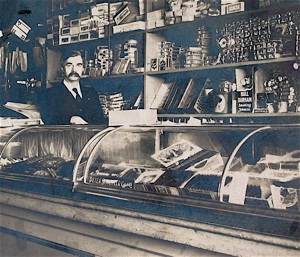
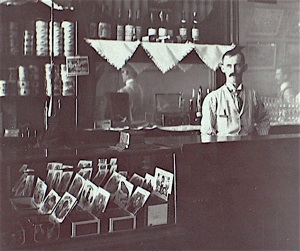


This guy’s approach is creative.
He rips the lids off, then stands them up behind the box, taking up half the visual space and still presenting the brand name or enough of the label illustration for the smoker to know what brand is being offered. If for some reason the customer wanted to see the whole label...
no problem. Simply lift it up.
Great for him. Not so good for today’s box collector.
[3656]

